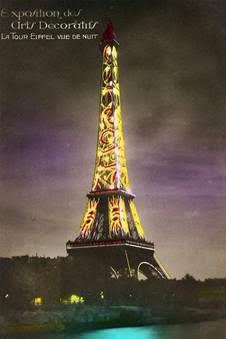1925 Paris Exposition
Oct 27, 2025
Issue 3770
At this year’s Symposium Sue Maynard delivered an engaging presentation on the 1925 Paris Art Deco Exhibition, detailing its lasting impact on global design and explored the outstanding exhibits. The fair, financed by the French government, aimed to promote modern design innovations, and attracted millions of visitors from around the world. The United States and numerous European nations were invited to showcase their latest work. However, at the time, the U.S. was criticized for lacking modern designs, which led to an official decision not to participate. Instead, Herbert Hoover, the U.S. Secretary of Commerce, appointed Frederick Carder as ‘Commissioner at Large’ to attend the Expo on behalf of the country. Carder, accompanied by his wife, traveled to France, where hundreds of American designers, artists, journalists, and department store buyers also attended.
The primary goal of the exposition was to present groundbreaking modern designs, avoiding historic styles in favor of new materials, bold colors, and innovative decorative elements. The fair was a pivotal moment in the development of American industrial and decorative arts. The presentation highlighted the profound influence the Expo had on shaping design trends worldwide, as its emphasis on modernity inspired future movements in architecture, fashion, and the decorative arts. The Exposition’s was described as a magical setting, with its theatrical arts, gardens, and amusement park, set on 85,500 acres along the Seine River, created a spectacular backdrop for the showcase of cutting-edge works.
Pavilions from various countries, including France, Austria, Belgium, Sweden, Italy, and Japan, where each country tried to outdo each other to impress visitors with their luxury furnishings, glassware, textiles, and more. These pavilions featured colorful entrances, sculptural friezes, and murals, while the interior rooms displayed exquisite ensembles of furniture, carpets, paintings, and decorative objects. The Exposition’s success cemented Paris’s position as the world leader in the arts of design, and though the term “Art Deco” wasn’t coined until later, the influence of the Expo spread globally. Its aesthetic resonated in the design of skyscrapers in New York, ocean liners, and movie theaters, as well as in fashion, jewelry, and furniture. Frederick Carder, in his reflections, praised the French for their artistry, particularly in glassware, such as ‘Pate-de-verre’ or ‘Glass paste’ which showcased the delicate craft of sculpting in glass.
Sue’s talk was filled with images that took us back in time showcasing the exposition’s exhibits, designer’s inspirations and what became the start of the Art Deco era where new decorative style was formed without reliance on tradition.
AUCTION OF INTEREST
We recently learned that the first of three auctions of Bill Mehlenbacher’s Carder Steuben glass collection is scheduled for November 20th at Cottone Auctions in Geneseo, NY. For those who knew and loved Bill, we thought you might appreciate the chance to have a piece from his wonderful collection. More information to follow.




